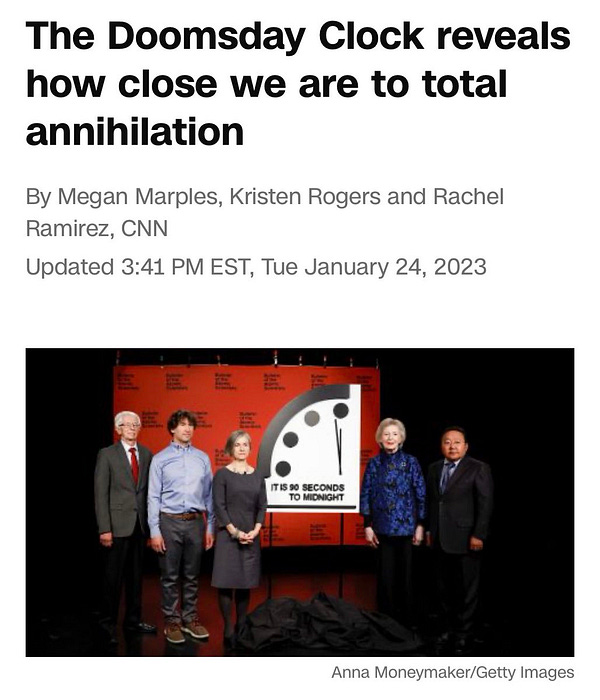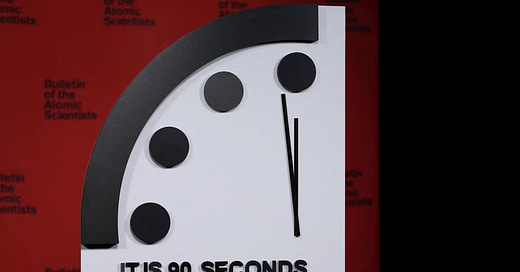For as long as I can remember, I’ve been unnerved by the Doomsday Clock.
Every few years, it pops up its head up to tell us we are ever closer to total and complete annihilation.
Witness earlier this week when the Clock moved to 90 seconds before midnight, meaning that, um, complete destruction is nigh. (The clock had been at 100 seconds to midnight from 2020-2022.)
Here’s how CNN described the moment:
“On Tuesday, the clock was set at 90 seconds until midnight — the closest to the hour it has ever been, according to the Bulletin of the Atomic Scientists, which created the clock in 1947. Midnight represents the moment at which we will have made Earth uninhabitable for humanity.”
Which seems worrisome! I am not a big fan of having made the earth “uninhabitable for humanity.” And with just 90 seconds left before that moment, well, maybe I should start to get my affairs in order. You too!
Except, unlike my momentary panics in the past, this time I started to read about what the Doomsday Clock is — and what it isn’t.
Here’s the official description from the Bulletin of the Atomic Scientists, who maintains it:
“The Doomsday Clock is many things all at once: It’s a metaphor, it’s a logo, it’s a brand, and it’s one of the most recognizable symbols in the past 100 years. It has permeated not only the media landscape but also culture itself. The Doomsday Clock appears in novels by Stephen King and Piers Anthony, songs by The Who and the Clash, and comics like Watchmen and Stormwatch.”
That’s the language taken from an advertisement for a coffee table book on the Doomsday Clock that the Bulletin of the Atomic Scientists are hocking on their website. Yes, seriously.
(Sidebar: “Watchmen” ruled. I am a Damon Lindelof completist — currently working my way through season 1 of “Lost.”)
The Doomsday Clock has been with us since 1947 when Albert Einstein, among others, came up with the idea as a way to symbolically measure the the threat posed by nuclear annihilation. (The Bulletin of the Atomic Scientists, which is a very weidly named group, was formed two years earlier.)
At the time, the clock was set at 7 minutes until midnight. The furthest we have ever been from nuclear annihilation is in 1991 when we were at 17 minutes to midnight. (As Reuters noted, that coincided with the end of the Cold War between Russia and the United States.)
The problem I have with the Doomsday Clock is that, well, it isn’t actually a clock. There’s a faux precision included in these yearly pronouncements that simply isn’t born out by the process of changing the clock’s “time.”
In explaining the decision to move the Doomsday Clock up 10 seconds this year, the Bulletin of the Atomic Scientists said that its prime motivation was the “mounting dangers of the war in Ukraine,” adding: “Russia’s thinly veiled threats to use nuclear weapons remind the world that escalation of the conflict—by accident, intention, or miscalculation—is a terrible risk. The possibility that the conflict could spin out of anyone’s control remains high.”
Yes! There’s no question that Russia’s ongoing war with Ukraine destabilizes the world. And that a cornered Vladimir Putin is a dangerous actor on the world stage.
But, why did the clock move exactly 10 seconds? Is there some kind of quantitative measure that led to that exact move? What is the scale that determines how much of how little the Clock moves? Or is it just, well, the whim of the Bulletin of Atomic Scientists?
The problem here is that the pronouncements of these atomic scientists — who are no doubt smart and serious people! — are treated as though they are guided by some underlying scientific method.
BREAKING NEWS: They aren’t! As Derek Thompson of The Atlantic put it:


Then there’s this: It’s in the interest of the Bulletin of the Atomic Scientists to change the clock regularly. They want to draw attention to the clock and to their work. They want to sell coffee table books on the clock. They want you to listen to their Spotify playlist on the Clock (yes, this exists.)
If the Clock never changes time — or, more accurately, “time” — there is no reason to ever pay attention to it or the group behind it! The Bulletin of the Atomic Scientists have the most basic motivation ever to make sure the time changes on occasion: Relevance!
What then does it mean that we are 10 second closer to total annihilation than we were for the last 3 years? Absolutely nothing!
It reminds me of when Dwight becomes the regional manager at Dunder Mifflin and introduces a currency known as a “Shrute Buck,” which is worth .0001 U.S. dollars. Meaning it would take $10,000 Shrute Bucks to equal $1.
I will give news organizations 1 bazillion Shrute Bucks to stop writing with such seriousness about the damn Doomsday Clock.





Bullshit? Loving uncensored Cillizza.
This is awesome - another major issue is the concept of an analog clock is just so outdated. The effectiveness of the metaphor is massively hindered by the significant percentage of the population who can't read an analog clock. https://youtu.be/ZvLKbhXqEKw